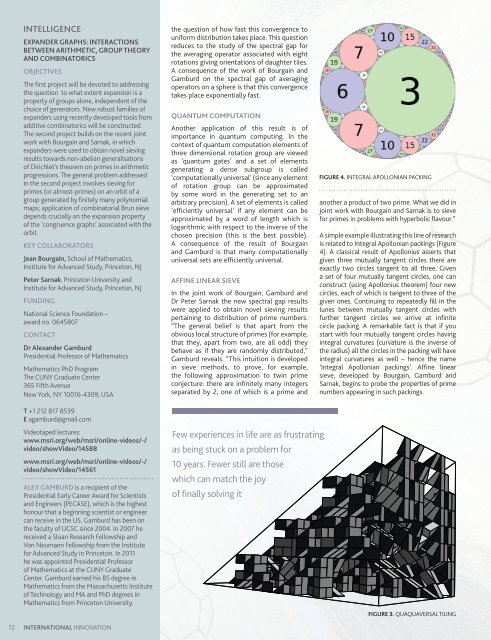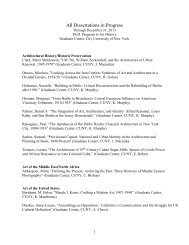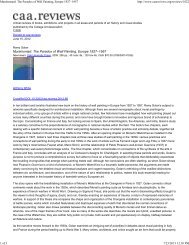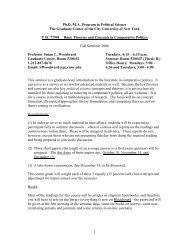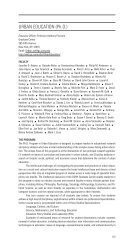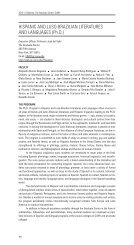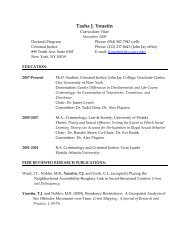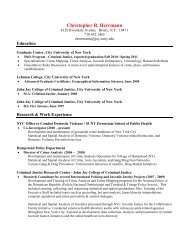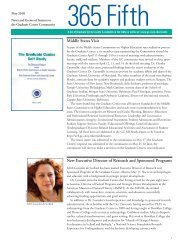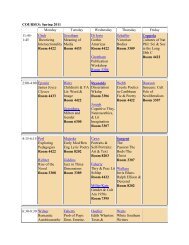Mathematical marvels - CUNY Graduate Center
Mathematical marvels - CUNY Graduate Center
Mathematical marvels - CUNY Graduate Center
You also want an ePaper? Increase the reach of your titles
YUMPU automatically turns print PDFs into web optimized ePapers that Google loves.
INTELLIGENCE<br />
EXPANDER GRAPHS: INTERACTIONS<br />
BETWEEN ARITHMETIC, GROUP THEORY<br />
AND COMBINATORICS<br />
OBJECTIVES<br />
The fi rst project will be devoted to addressing<br />
the question to what extent expansion is a<br />
property of groups alone, independent of the<br />
choice of generators. New robust families of<br />
expanders using recently developed tools from<br />
additive combinatorics will be constructed.<br />
The second project builds on the recent joint<br />
work with Bourgain and Sarnak, in which<br />
expanders were used to obtain novel sieving<br />
results towards non-abelian generalisations<br />
of Dirichlet’s theorem on primes in arithmetic<br />
progressions. The general problem addressed<br />
in the second project involves sieving for<br />
primes (or almost-primes) on an orbit of a<br />
group generated by fi nitely many polynomial<br />
maps; application of combinatorial Brun sieve<br />
depends crucially on the expansion property<br />
of the ‘congruence graphs’ associated with the<br />
orbit.<br />
KEY COLLABORATORS<br />
Jean Bourgain, School of Mathematics,<br />
Institute for Advanced Study, Princeton, NJ<br />
Peter Sarnak, Princeton University and<br />
Institute for Advanced Study, Princeton, NJ<br />
FUNDING<br />
National Science Foundation –<br />
award no. 0645807<br />
CONTACT<br />
Dr Alexander Gamburd<br />
Presidential Professor of Mathematics<br />
Mathematics PhD Program<br />
The <strong>CUNY</strong> <strong>Graduate</strong> <strong>Center</strong><br />
365 Fifth Avenue<br />
New York, NY 10016-4309, USA<br />
T +1 212 817 8539<br />
E agamburd@gmail.com<br />
Videotaped lectures:<br />
www.msri.org/web/msri/online-videos/-/<br />
video/showVideo/14588<br />
www.msri.org/web/msri/online-videos/-/<br />
video/showVideo/14561<br />
ALEX GAMBURD is a recipient of the<br />
Presidential Early Career Award for Scientists<br />
and Engineers (PECASE), which is the highest<br />
honour that a beginning scientist or engineer<br />
can receive in the US. Gamburd has been on<br />
the faculty of UCSC since 2004. In 2007 he<br />
received a Sloan Research Fellowship and<br />
Von Neumann Fellowship from the Institute<br />
for Advanced Study in Princeton. In 2011<br />
he was appointed Presidential Professor<br />
of Mathematics at the <strong>CUNY</strong> <strong>Graduate</strong><br />
<strong>Center</strong>. Gamburd earned his BS degree in<br />
Mathematics from the Massachusetts Institute<br />
of Technology and MA and PhD degrees in<br />
Mathematics from Princeton University.<br />
72 INTERNATIONAL INNOVATION<br />
the question of how fast this convergence to<br />
uniform distribution takes place. This question<br />
reduces to the study of the spectral gap for<br />
the averaging operator associated with eight<br />
rotations giving orientations of daughter tiles.<br />
A consequence of the work of Bourgain and<br />
Gamburd on the spectral gap of averaging<br />
operators on a sphere is that this convergence<br />
takes place exponentially fast.<br />
QUANTUM COMPUTATION<br />
Another application of this result is of<br />
importance in quantum computing. In the<br />
context of quantum computation elements of<br />
three dimensional rotation group are viewed<br />
as ‘quantum gates’ and a set of elements<br />
generating a dense subgroup is called<br />
‘computationally universal’ (since any element<br />
of rotation group can be approximated<br />
by some word in the generating set to an<br />
arbitrary precision). A set of elements is called<br />
‘effi ciently universal’ if any element can be<br />
approximated by a word of length which is<br />
logarithmic with respect to the inverse of the<br />
chosen precision (this is the best possible).<br />
A consequence of the result of Bourgain<br />
and Gamburd is that many computationally<br />
universal sets are effi ciently universal.<br />
AFFINE LINEAR SIEVE<br />
In the joint work of Bourgain, Gamburd and<br />
Dr Peter Sarnak the new spectral gap results<br />
were applied to obtain novel sieving results<br />
pertaining to distribution of prime numbers.<br />
“The general belief is that apart from the<br />
obvious local structure of primes (for example,<br />
that they, apart from two, are all odd) they<br />
behave as if they are randomly distributed,”<br />
Gamburd reveals. “This intuition is developed<br />
in sieve methods, to prove, for example,<br />
the following approximation to twin prime<br />
conjecture: there are infi nitely many integers<br />
separated by 2, one of which is a prime and<br />
Few experiences in life are as frustrating<br />
as being stuck on a problem for<br />
10 years. Fewer still are those<br />
which can match the joy<br />
of fi nally solving it<br />
FIGURE 4. INTEGRAL APOLLONIAN PACKING<br />
another a product of two prime. What we did in<br />
joint work with Bourgain and Sarnak is to sieve<br />
for primes in problems with hyperbolic fl avour.”<br />
A simple example illustrating this line of research<br />
is related to Integral Apollonian packings (Figure<br />
4). A classical result of Apollonius asserts that<br />
given three mutually tangent circles there are<br />
exactly two circles tangent to all three. Given<br />
a set of four mutually tangent circles, one can<br />
construct (using Apollonius theorem) four new<br />
circles, each of which is tangent to three of the<br />
given ones. Continuing to repeatedly fi ll in the<br />
lunes between mutually tangent circles with<br />
further tangent circles we arrive at infi nite<br />
circle packing. A remarkable fact is that if you<br />
start with four mutually tangent circles having<br />
integral curvatures (curvature is the inverse of<br />
the radius) all the circles in the packing will have<br />
integral curvatures as well – hence the name<br />
‘Integral Apollonian packings’. Affi ne linear<br />
sieve, developed by Bourgain, Gamburd and<br />
Sarnak, begins to probe the properties of prime<br />
numbers appearing in such packings.<br />
FIGURE 3. QUAQUAVERSAL TILING


